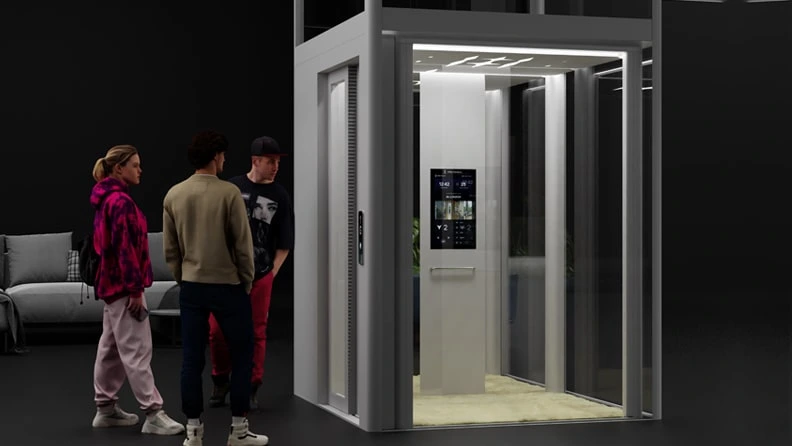Table of Contents
Introduction
In the world of modern home design, elevators are no longer just a luxury. They are becoming essential for many homeowners, particularly those with multi-story residences. Whether you are looking to add convenience, increase the value of your home, or ensure accessibility for all family members, choosing the right elevator is crucial. This guide will help you navigate the different types of home elevators, key features, installation considerations, and more.
Why Consider a Home Elevator?
Home elevators are more than just a practical addition to your home; they represent a blend of convenience, luxury, and accessibility. Whether you have elderly family members, young children, or simply want to future-proof your home, an elevator can be an invaluable asset.
Benefits of Installing a Home Elevator
Enhanced Accessibility: Facilitates movement for the elderly or disabled.
Increased Property Value: Elevators can significantly boost your home’s market value.
Convenience: Makes it easier to transport heavy items like groceries, luggage, or furniture between floors.
Safety: Modern elevators come equipped with advanced safety features to prevent accidents.
Types of Home Elevators
Choosing the right type of elevator depends on your specific needs, the layout of your home, and your budget. Here’s a breakdown of the most popular types:
Hydraulic Elevators
Hydraulic elevators are a popular choice for residential use due to their smooth operation and capacity to handle heavier loads.
How It Works: Uses a piston and hydraulic fluid to move the elevator car.
Pros: Quiet, smooth, and capable of lifting heavy loads.
Cons: Requires a separate machine room, which can increase installation costs.
Traction Elevators
Traction elevators are another common type, often found in both commercial and residential buildings.
How It Works: Operates using a counterweight system and cables.Pros: Energy-efficient and suitable for multi-story homes.
Cons: Slightly noisier than hydraulic elevators and typically more expensive.
Pneumatic Elevators
Pneumatic elevators, also known as vacuum elevators, are a relatively new addition to the residential market.
How It Works: Uses air pressure to move the car up and down.
Pros: Space-saving, no machine room required, and quick installation.
Cons: Limited weight capacity and higher maintenance costs.
Chain-Driven Elevators
Chain-driven elevators are known for their durability and compact design, making them ideal for homes with space constraints.
How It Works: Operates with a chain mechanism instead of cables.
Pros: Requires less maintenance and no machine room.
Cons: Not as smooth as other types and can be noisier.
Key Features to Look for in a Home Elevator
When choosing a home elevator, it’s essential to consider the features that will offer the most value and comfort.
Safety Features
Safety should always be a top priority. Look for elevators with:
Emergency Stop Button: Allows passengers to halt the elevator in an emergency.
Battery Backup: Keeps the elevator operational during power outages.
Obstruction Sensors: Detects obstacles and prevents accidents.
Automatic Doors: Reduces the risk of injury by eliminating manual door operation.
Energy Efficiency
Energy-efficient elevators are not only better for the environment but also help reduce long-term operational costs.
LED Lighting: Consumes less power and lasts longer.
Regenerative Drives: Capture and reuse energy during operation.
Sleep Mode: Powers down the elevator when not in use, saving energy.
Customization Options
Your elevator should match your home’s style and your personal taste. Consider options like:
Cabin Finishes: Choose from materials such as wood, glass, or metal.
Lighting: Add ambiance with LED lights or mood lighting.
Control Panels: Opt for sleek, modern designs with touch screens or traditional buttons.
Installation and Maintenance Considerations
Installing a home elevator is a significant project that requires careful planning.
Choosing the Right Installation Team
Select an experienced company with a proven track record in home elevator installations. They should provide:
Detailed Home Assessment: To determine the best type of elevator and location.
Clear Timeline and Cost Estimate: So you know what to expect.
Compliance with Local Codes: Ensuring your installation meets safety standards.
Maintenance Requirements
Regular maintenance is crucial to keep your elevator in top condition. Each type of elevator has different maintenance needs:
Hydraulic Elevators: Regular checks of hydraulic fluid and seals.
Traction Elevators: Inspections of cables and counterweights.
Pneumatic Elevators: Frequent checks due to specialized technology.
Consider signing a maintenance contract with your installation company to ensure consistent upkeep.
Cost Considerations
The cost of a home elevator can vary widely based on several factors, including the type of elevator, customization options, and installation complexity.
Initial Costs
Hydraulic Elevators: Typically more expensive due to the need for a machine room.
Traction Elevators: Mid-range cost, suitable for taller homes.
Pneumatic Elevators: Often more affordable for homes with limited space.
Long-Term Costs
Beyond installation, consider the long-term costs of operating and maintaining your elevator.
Energy Efficiency: Opt for models with lower energy consumption to save on utility bills.
Maintenance: Regular service is essential to prevent costly repairs.
Making the Final Decision
Choosing the right elevator for your home is a significant decision that requires careful consideration of your needs, budget, and home design.
Consult with Experts
Before making a final choice, consult with experts who can provide tailored advice based on your home’s layout and your specific requirements. Many companies offer free consultations, allowing you to make an informed decision.
Conclusion
Selecting the right elevator for your home is a decision that can enhance your lifestyle, increase your property value, and ensure accessibility for all residents. By understanding the different types of elevators, key features, and installation considerations, you can choose an elevator that meets your needs and complements your home’s design. Whether you prioritize luxury, convenience, or safety, the right home elevator can make a significant difference in your daily life.

